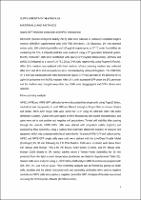| dc.contributor | Vall d'Hebron Barcelona Hospital Campus |
| dc.contributor.author | Duarri Piqué, Anna |
| dc.contributor.author | Rodríguez-Bocanegra, Eduardo |
| dc.contributor.author | Martínez-Navarrete, Gema |
| dc.contributor.author | García, Miriam |
| dc.contributor.author | Ferraro, Lucía Lee |
| dc.contributor.author | Biarnés, Marc |
| dc.date.accessioned | 2022-05-02T12:56:25Z |
| dc.date.available | 2022-05-02T12:56:25Z |
| dc.date.issued | 2021-10 |
| dc.identifier.citation | Duarri A, Rodríguez-Bocanegra E, Martínez-Navarrete G, Biarnés M, García M, Ferraro LL, et al. Transplantation of Human Induced Pluripotent Stem Cell-Derived Retinal Pigment Epithelium in a Swine Model of Geographic Atrophy. Int J Mol Sci. 2021 Oct;22(19):10497. |
| dc.identifier.issn | 1422-0067 |
| dc.identifier.uri | https://hdl.handle.net/11351/7441 |
| dc.description | Animal model; Regenerative medicine; Retina |
| dc.description.abstract | Background: The aim of this study was to test the feasibility and safety of subretinal transplantation of human induced pluripotent stem cell (hiPSC)-derived retinal pigment epithelium (RPE) cells into the healthy margins and within areas of degenerative retina in a swine model of geographic atrophy (GA). Methods: Well-delimited selective outer retinal damage was induced by subretinal injection of NaIO3 into one eye in minipigs (n = 10). Thirty days later, a suspension of hiPSC-derived RPE cells expressing green fluorescent protein was injected into the subretinal space, into the healthy margins, and within areas of degenerative retina. In vivo follow-up was performed by multimodal imaging. Post-mortem retinas were analyzed by immunohistochemistry and histology. Results: In vitro differentiated hiPSC-RPE cells showed a typical epithelial morphology, expressed RPE-related genes, and had phagocytic ability. Engrafted hiPSC-RPE cells were detected in 60% of the eyes, forming mature epithelium in healthy retina extending towards the border of the atrophy. Histological analysis revealed RPE interaction with host photoreceptors in the healthy retina. Engrafted cells in the atrophic zone were found in a patchy distribution but failed to form an epithelial-like layer. Conclusions: These results might support the use of hiPSC-RPE cells to treat atrophic GA by providing a housekeeping function to aid the overwhelmed remnant RPE, which might improve its survival and therefore slow down the progression of GA. |
| dc.language.iso | eng |
| dc.publisher | MDPI |
| dc.relation.ispartofseries | International Journal of Molecular Sciences;22(19) |
| dc.rights | Attribution 4.0 International |
| dc.rights.uri | http://creativecommons.org/licenses/by/4.0/ |
| dc.source | Scientia |
| dc.subject | Retina - Malalties - Trasplantació |
| dc.subject | Cèl·lules mare adultes |
| dc.subject | Degeneració macular - Cirurgia |
| dc.subject.mesh | Retinal Pigment Epithelium |
| dc.subject.mesh | /transplantation |
| dc.subject.mesh | Induced Pluripotent Stem Cells |
| dc.subject.mesh | Geographic Atrophy |
| dc.title | Transplantation of Human Induced Pluripotent Stem Cell-Derived Retinal Pigment Epithelium in a Swine Model of Geographic Atrophy |
| dc.type | info:eu-repo/semantics/article |
| dc.identifier.doi | 10.3390/ijms221910497 |
| dc.subject.decs | epitelio pigmentado de la retina |
| dc.subject.decs | /trasplante |
| dc.subject.decs | células madre pluripotentes inducidas |
| dc.subject.decs | atrofia geográfica |
| dc.relation.publishversion | https://doi.org/10.3390/ijms221910497 |
| dc.type.version | info:eu-repo/semantics/publishedVersion |
| dc.audience | Professionals |
| dc.contributor.organismes | Institut Català de la Salut |
| dc.contributor.authoraffiliation | [Duarri A] Program for Clinical Translation of Regenerative Medicine in Catalonia–P-CMR[C], Bellvitge Biomedical Research Institute (IDIBELL), Hospitalet de Llobregat, 08908 Barcelona, Spain. National Stem Cell Bank-Barcelona Node, Biomolecular and Bioinformatics Resources Platform PRB2, ISCIII, IDIBELL, Hospitalet de Llobregat, 08908 Barcelona, Spain. Grup de Recerca en Oftalmologia, Vall d’Hebron Institut de Recerca (VHIR), Barcelona, Spain. [Rodríguez-Bocanegra E, Biarnés M, García M, Ferraro LL] Barcelona Macula Foundation: Research for Vision, 08022 Barcelona, Spain. Institut de la Màcula, Centro Médico Teknon, 08022 Barcelona, Spain. [Martínez-Navarrete G] Networking Research Center of Bioengineering, Biomaterials and Nanomedicine (CIBER-BBN), 28029 Madrid, Spain. Institute of Bioengineering, Universidad Miguel Hernández, 03202 Alicante, Spain |
| dc.identifier.pmid | 34638840 |
| dc.identifier.wos | 000756327600001 |
| dc.relation.projectid | info:eu-repo/grantAgreement/ES/PE2017-2020/AC19%2F00080 |
| dc.rights.accessrights | info:eu-repo/semantics/openAccess |


